Case Study Analysis: GCNNK2 Nursing Knowledge 2 Assessment
VerifiedAdded on 2022/08/10
|11
|2888
|29
Case Study
AI Summary
This case study analysis examines the nursing care of Mrs. Jane, an elderly patient admitted to the emergency department following a fall. The paper assesses the patient's vital signs, medical history, and presenting symptoms, including deviations in heart rate, temperature, pain level, and cognition. It delves into the pathophysiology of her conditions, considering her history of hypothyroidism, hypertension, atrial fibrillation, and ischemic heart disease, as well as the impact of her fall. The analysis identifies key nursing diagnoses, such as risk of falls, pressure ulcer development, severe pain, and risk of sudden cardiac arrest, and proposes appropriate interventions, including pain management, medication management, and patient education. Furthermore, it explores the pharmacokinetics of prescribed medications, including Bupivacaine + fentanyl femoral block, Panadol, Morphine, and Neurofen, and discusses the importance of evidence-based practice and patient-centered care in nursing management. The paper emphasizes the role of the nurse in patient education, risk management, and overall care delivery.
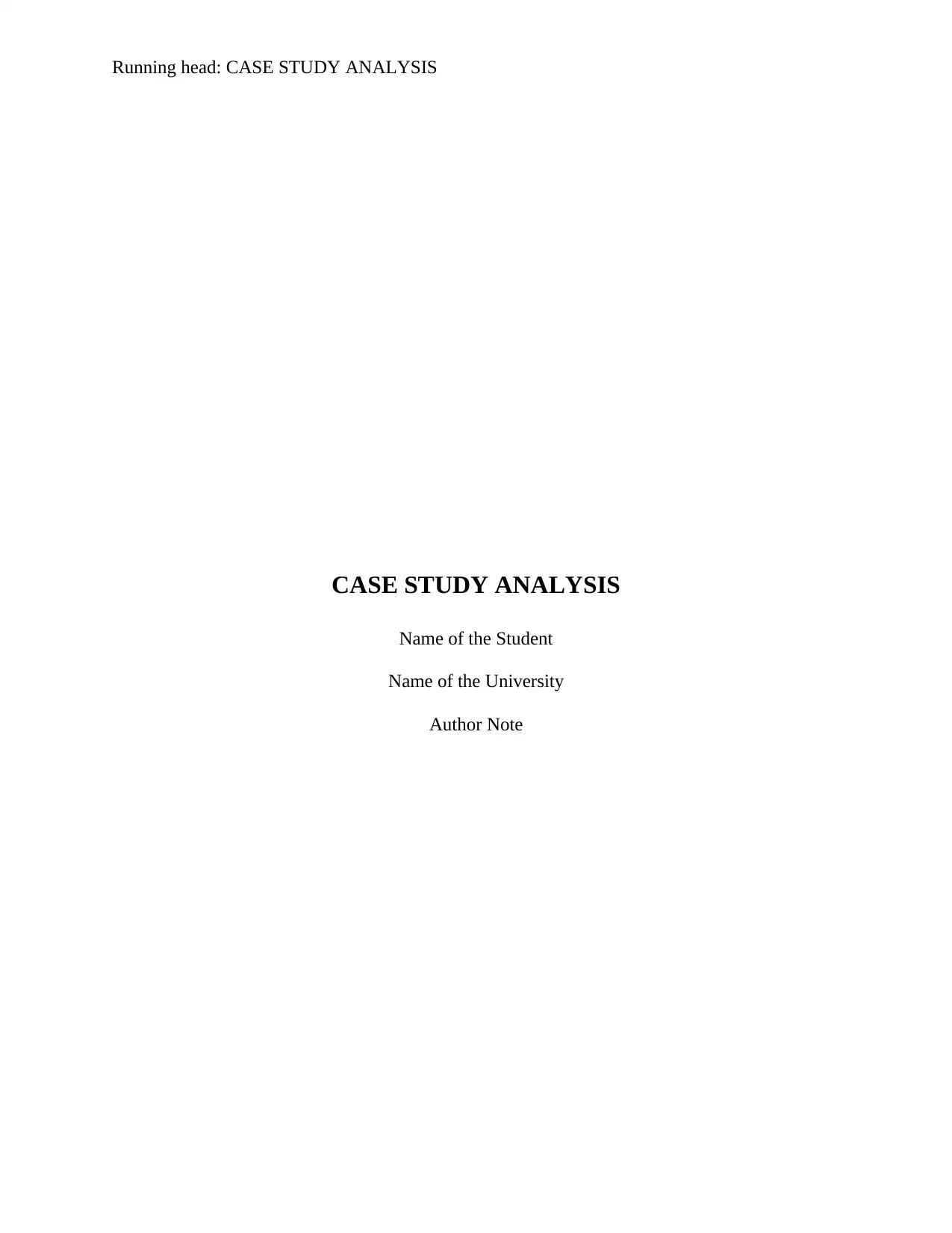
Running head: CASE STUDY ANALYSIS
CASE STUDY ANALYSIS
Name of the Student
Name of the University
Author Note
CASE STUDY ANALYSIS
Name of the Student
Name of the University
Author Note
Paraphrase This Document
Need a fresh take? Get an instant paraphrase of this document with our AI Paraphraser
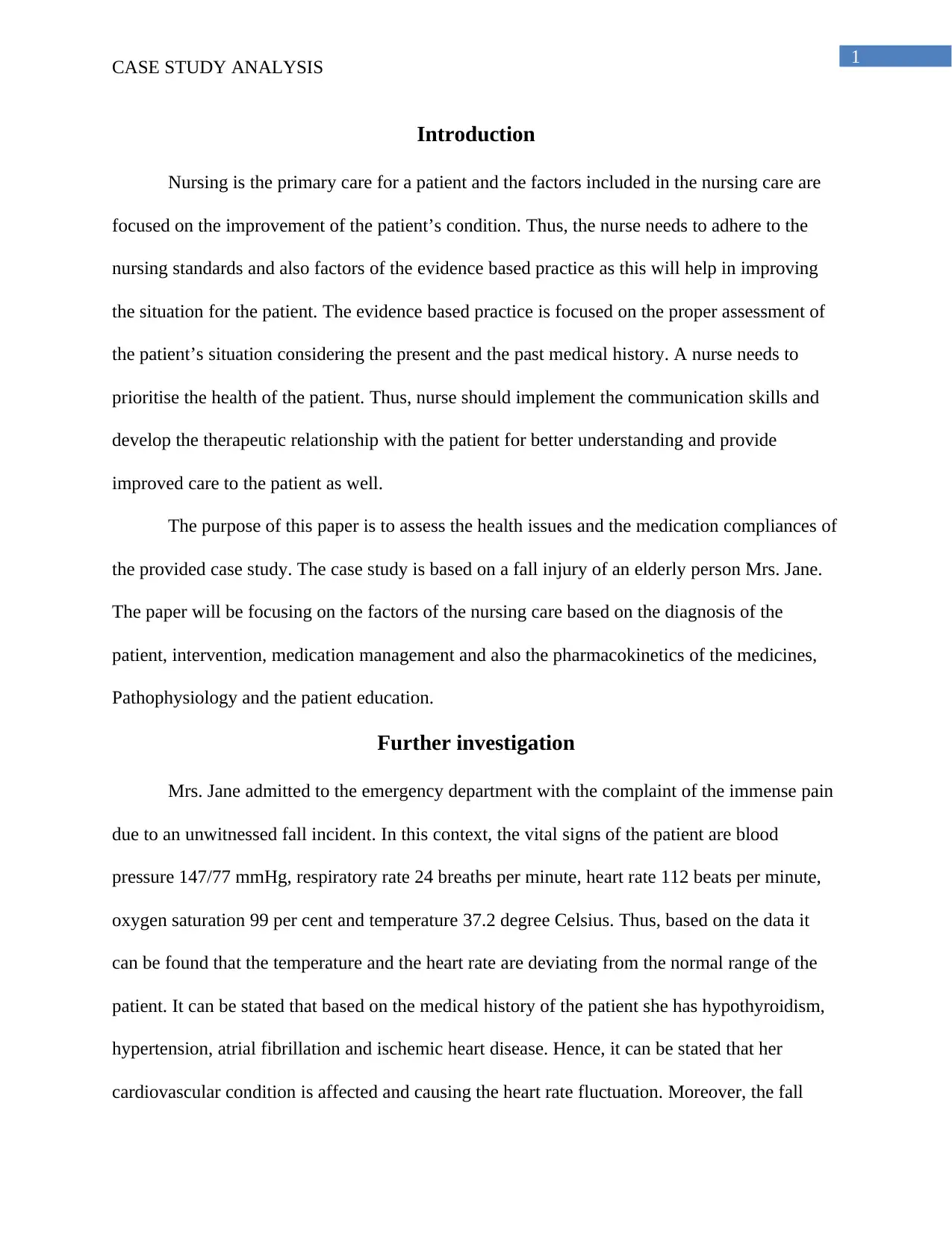
1
CASE STUDY ANALYSIS
Introduction
Nursing is the primary care for a patient and the factors included in the nursing care are
focused on the improvement of the patient’s condition. Thus, the nurse needs to adhere to the
nursing standards and also factors of the evidence based practice as this will help in improving
the situation for the patient. The evidence based practice is focused on the proper assessment of
the patient’s situation considering the present and the past medical history. A nurse needs to
prioritise the health of the patient. Thus, nurse should implement the communication skills and
develop the therapeutic relationship with the patient for better understanding and provide
improved care to the patient as well.
The purpose of this paper is to assess the health issues and the medication compliances of
the provided case study. The case study is based on a fall injury of an elderly person Mrs. Jane.
The paper will be focusing on the factors of the nursing care based on the diagnosis of the
patient, intervention, medication management and also the pharmacokinetics of the medicines,
Pathophysiology and the patient education.
Further investigation
Mrs. Jane admitted to the emergency department with the complaint of the immense pain
due to an unwitnessed fall incident. In this context, the vital signs of the patient are blood
pressure 147/77 mmHg, respiratory rate 24 breaths per minute, heart rate 112 beats per minute,
oxygen saturation 99 per cent and temperature 37.2 degree Celsius. Thus, based on the data it
can be found that the temperature and the heart rate are deviating from the normal range of the
patient. It can be stated that based on the medical history of the patient she has hypothyroidism,
hypertension, atrial fibrillation and ischemic heart disease. Hence, it can be stated that her
cardiovascular condition is affected and causing the heart rate fluctuation. Moreover, the fall
CASE STUDY ANALYSIS
Introduction
Nursing is the primary care for a patient and the factors included in the nursing care are
focused on the improvement of the patient’s condition. Thus, the nurse needs to adhere to the
nursing standards and also factors of the evidence based practice as this will help in improving
the situation for the patient. The evidence based practice is focused on the proper assessment of
the patient’s situation considering the present and the past medical history. A nurse needs to
prioritise the health of the patient. Thus, nurse should implement the communication skills and
develop the therapeutic relationship with the patient for better understanding and provide
improved care to the patient as well.
The purpose of this paper is to assess the health issues and the medication compliances of
the provided case study. The case study is based on a fall injury of an elderly person Mrs. Jane.
The paper will be focusing on the factors of the nursing care based on the diagnosis of the
patient, intervention, medication management and also the pharmacokinetics of the medicines,
Pathophysiology and the patient education.
Further investigation
Mrs. Jane admitted to the emergency department with the complaint of the immense pain
due to an unwitnessed fall incident. In this context, the vital signs of the patient are blood
pressure 147/77 mmHg, respiratory rate 24 breaths per minute, heart rate 112 beats per minute,
oxygen saturation 99 per cent and temperature 37.2 degree Celsius. Thus, based on the data it
can be found that the temperature and the heart rate are deviating from the normal range of the
patient. It can be stated that based on the medical history of the patient she has hypothyroidism,
hypertension, atrial fibrillation and ischemic heart disease. Hence, it can be stated that her
cardiovascular condition is affected and causing the heart rate fluctuation. Moreover, the fall
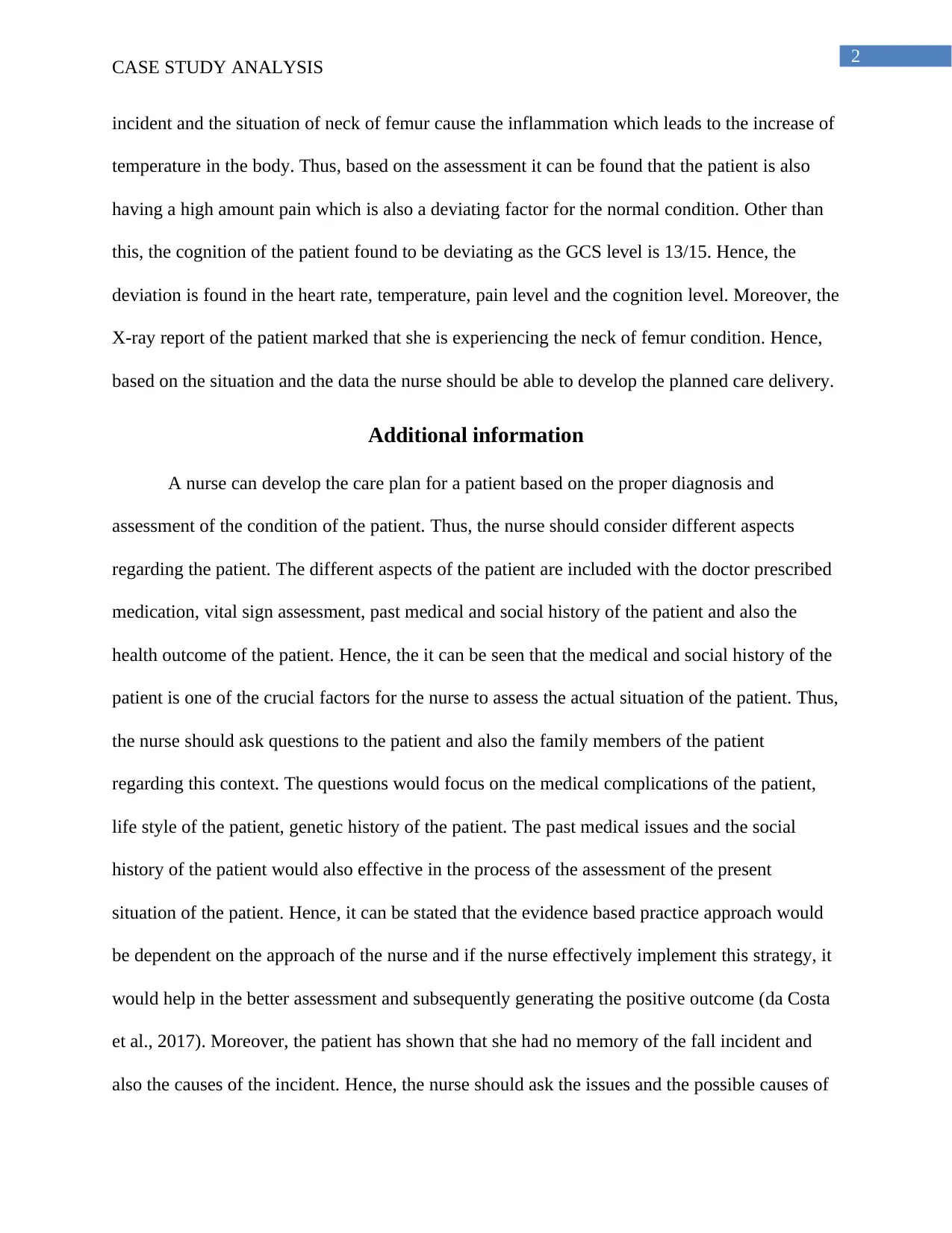
2
CASE STUDY ANALYSIS
incident and the situation of neck of femur cause the inflammation which leads to the increase of
temperature in the body. Thus, based on the assessment it can be found that the patient is also
having a high amount pain which is also a deviating factor for the normal condition. Other than
this, the cognition of the patient found to be deviating as the GCS level is 13/15. Hence, the
deviation is found in the heart rate, temperature, pain level and the cognition level. Moreover, the
X-ray report of the patient marked that she is experiencing the neck of femur condition. Hence,
based on the situation and the data the nurse should be able to develop the planned care delivery.
Additional information
A nurse can develop the care plan for a patient based on the proper diagnosis and
assessment of the condition of the patient. Thus, the nurse should consider different aspects
regarding the patient. The different aspects of the patient are included with the doctor prescribed
medication, vital sign assessment, past medical and social history of the patient and also the
health outcome of the patient. Hence, the it can be seen that the medical and social history of the
patient is one of the crucial factors for the nurse to assess the actual situation of the patient. Thus,
the nurse should ask questions to the patient and also the family members of the patient
regarding this context. The questions would focus on the medical complications of the patient,
life style of the patient, genetic history of the patient. The past medical issues and the social
history of the patient would also effective in the process of the assessment of the present
situation of the patient. Hence, it can be stated that the evidence based practice approach would
be dependent on the approach of the nurse and if the nurse effectively implement this strategy, it
would help in the better assessment and subsequently generating the positive outcome (da Costa
et al., 2017). Moreover, the patient has shown that she had no memory of the fall incident and
also the causes of the incident. Hence, the nurse should ask the issues and the possible causes of
CASE STUDY ANALYSIS
incident and the situation of neck of femur cause the inflammation which leads to the increase of
temperature in the body. Thus, based on the assessment it can be found that the patient is also
having a high amount pain which is also a deviating factor for the normal condition. Other than
this, the cognition of the patient found to be deviating as the GCS level is 13/15. Hence, the
deviation is found in the heart rate, temperature, pain level and the cognition level. Moreover, the
X-ray report of the patient marked that she is experiencing the neck of femur condition. Hence,
based on the situation and the data the nurse should be able to develop the planned care delivery.
Additional information
A nurse can develop the care plan for a patient based on the proper diagnosis and
assessment of the condition of the patient. Thus, the nurse should consider different aspects
regarding the patient. The different aspects of the patient are included with the doctor prescribed
medication, vital sign assessment, past medical and social history of the patient and also the
health outcome of the patient. Hence, the it can be seen that the medical and social history of the
patient is one of the crucial factors for the nurse to assess the actual situation of the patient. Thus,
the nurse should ask questions to the patient and also the family members of the patient
regarding this context. The questions would focus on the medical complications of the patient,
life style of the patient, genetic history of the patient. The past medical issues and the social
history of the patient would also effective in the process of the assessment of the present
situation of the patient. Hence, it can be stated that the evidence based practice approach would
be dependent on the approach of the nurse and if the nurse effectively implement this strategy, it
would help in the better assessment and subsequently generating the positive outcome (da Costa
et al., 2017). Moreover, the patient has shown that she had no memory of the fall incident and
also the causes of the incident. Hence, the nurse should ask the issues and the possible causes of
⊘ This is a preview!⊘
Do you want full access?
Subscribe today to unlock all pages.

Trusted by 1+ million students worldwide
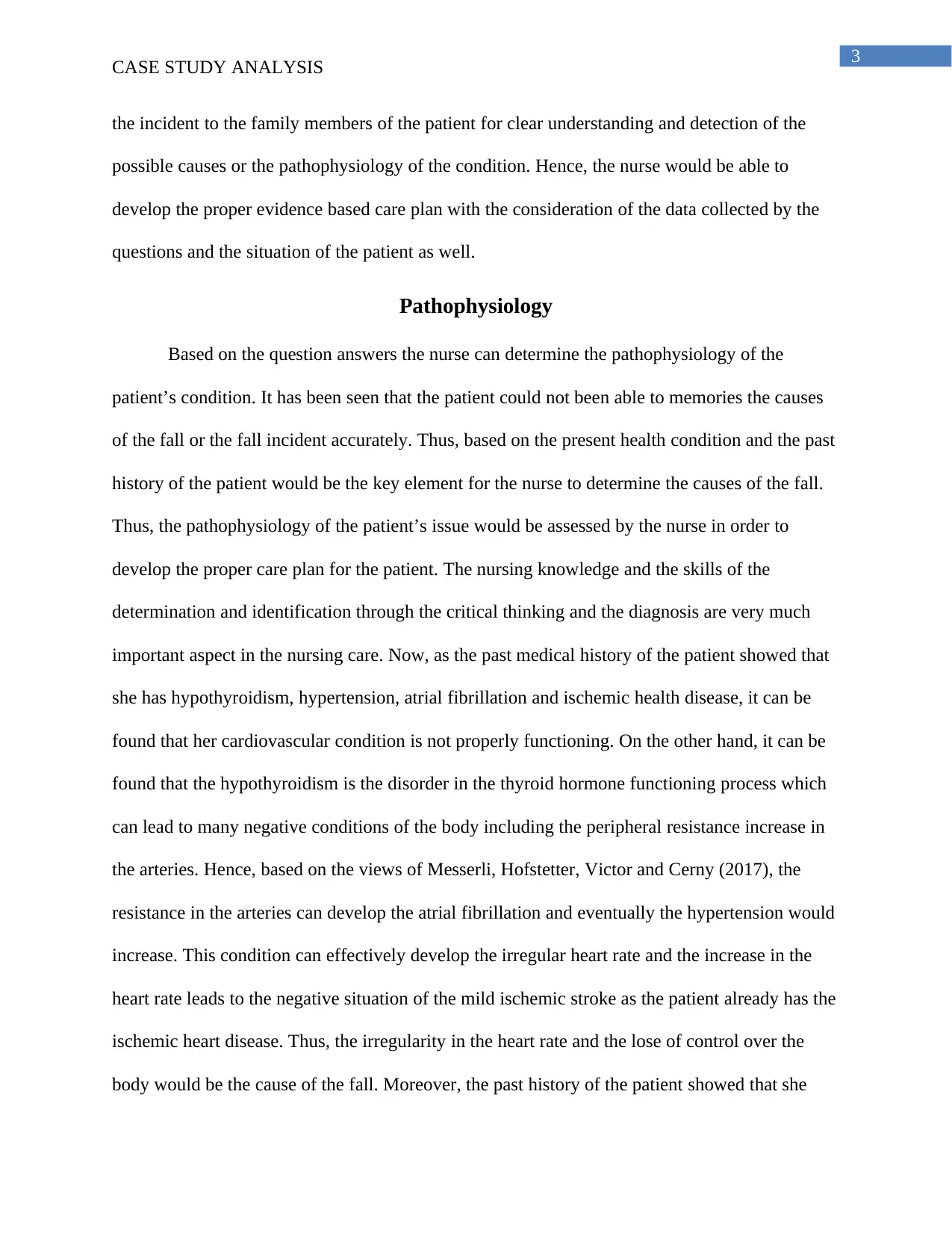
3
CASE STUDY ANALYSIS
the incident to the family members of the patient for clear understanding and detection of the
possible causes or the pathophysiology of the condition. Hence, the nurse would be able to
develop the proper evidence based care plan with the consideration of the data collected by the
questions and the situation of the patient as well.
Pathophysiology
Based on the question answers the nurse can determine the pathophysiology of the
patient’s condition. It has been seen that the patient could not been able to memories the causes
of the fall or the fall incident accurately. Thus, based on the present health condition and the past
history of the patient would be the key element for the nurse to determine the causes of the fall.
Thus, the pathophysiology of the patient’s issue would be assessed by the nurse in order to
develop the proper care plan for the patient. The nursing knowledge and the skills of the
determination and identification through the critical thinking and the diagnosis are very much
important aspect in the nursing care. Now, as the past medical history of the patient showed that
she has hypothyroidism, hypertension, atrial fibrillation and ischemic health disease, it can be
found that her cardiovascular condition is not properly functioning. On the other hand, it can be
found that the hypothyroidism is the disorder in the thyroid hormone functioning process which
can lead to many negative conditions of the body including the peripheral resistance increase in
the arteries. Hence, based on the views of Messerli, Hofstetter, Victor and Cerny (2017), the
resistance in the arteries can develop the atrial fibrillation and eventually the hypertension would
increase. This condition can effectively develop the irregular heart rate and the increase in the
heart rate leads to the negative situation of the mild ischemic stroke as the patient already has the
ischemic heart disease. Thus, the irregularity in the heart rate and the lose of control over the
body would be the cause of the fall. Moreover, the past history of the patient showed that she
CASE STUDY ANALYSIS
the incident to the family members of the patient for clear understanding and detection of the
possible causes or the pathophysiology of the condition. Hence, the nurse would be able to
develop the proper evidence based care plan with the consideration of the data collected by the
questions and the situation of the patient as well.
Pathophysiology
Based on the question answers the nurse can determine the pathophysiology of the
patient’s condition. It has been seen that the patient could not been able to memories the causes
of the fall or the fall incident accurately. Thus, based on the present health condition and the past
history of the patient would be the key element for the nurse to determine the causes of the fall.
Thus, the pathophysiology of the patient’s issue would be assessed by the nurse in order to
develop the proper care plan for the patient. The nursing knowledge and the skills of the
determination and identification through the critical thinking and the diagnosis are very much
important aspect in the nursing care. Now, as the past medical history of the patient showed that
she has hypothyroidism, hypertension, atrial fibrillation and ischemic health disease, it can be
found that her cardiovascular condition is not properly functioning. On the other hand, it can be
found that the hypothyroidism is the disorder in the thyroid hormone functioning process which
can lead to many negative conditions of the body including the peripheral resistance increase in
the arteries. Hence, based on the views of Messerli, Hofstetter, Victor and Cerny (2017), the
resistance in the arteries can develop the atrial fibrillation and eventually the hypertension would
increase. This condition can effectively develop the irregular heart rate and the increase in the
heart rate leads to the negative situation of the mild ischemic stroke as the patient already has the
ischemic heart disease. Thus, the irregularity in the heart rate and the lose of control over the
body would be the cause of the fall. Moreover, the past history of the patient showed that she
Paraphrase This Document
Need a fresh take? Get an instant paraphrase of this document with our AI Paraphraser
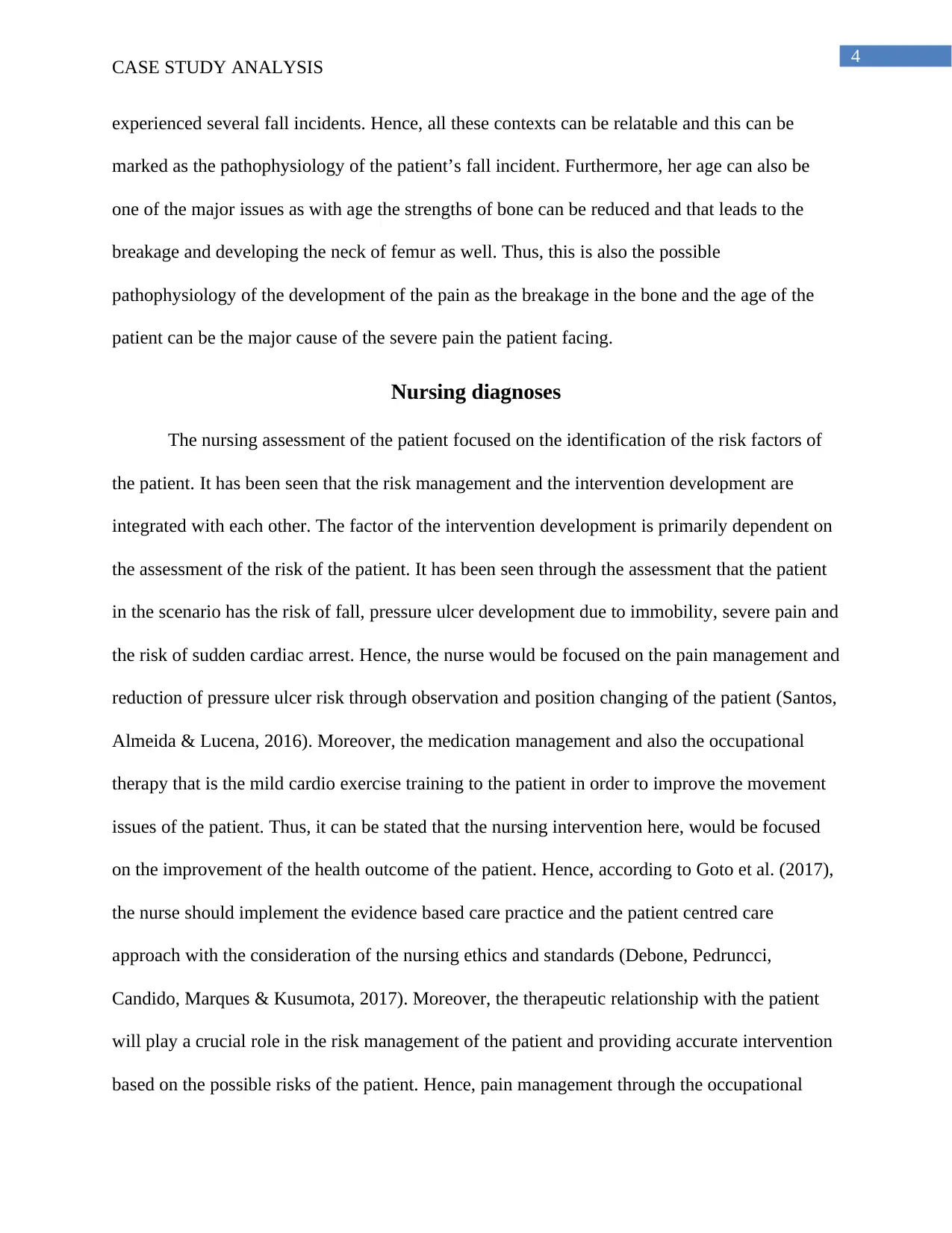
4
CASE STUDY ANALYSIS
experienced several fall incidents. Hence, all these contexts can be relatable and this can be
marked as the pathophysiology of the patient’s fall incident. Furthermore, her age can also be
one of the major issues as with age the strengths of bone can be reduced and that leads to the
breakage and developing the neck of femur as well. Thus, this is also the possible
pathophysiology of the development of the pain as the breakage in the bone and the age of the
patient can be the major cause of the severe pain the patient facing.
Nursing diagnoses
The nursing assessment of the patient focused on the identification of the risk factors of
the patient. It has been seen that the risk management and the intervention development are
integrated with each other. The factor of the intervention development is primarily dependent on
the assessment of the risk of the patient. It has been seen through the assessment that the patient
in the scenario has the risk of fall, pressure ulcer development due to immobility, severe pain and
the risk of sudden cardiac arrest. Hence, the nurse would be focused on the pain management and
reduction of pressure ulcer risk through observation and position changing of the patient (Santos,
Almeida & Lucena, 2016). Moreover, the medication management and also the occupational
therapy that is the mild cardio exercise training to the patient in order to improve the movement
issues of the patient. Thus, it can be stated that the nursing intervention here, would be focused
on the improvement of the health outcome of the patient. Hence, according to Goto et al. (2017),
the nurse should implement the evidence based care practice and the patient centred care
approach with the consideration of the nursing ethics and standards (Debone, Pedruncci,
Candido, Marques & Kusumota, 2017). Moreover, the therapeutic relationship with the patient
will play a crucial role in the risk management of the patient and providing accurate intervention
based on the possible risks of the patient. Hence, pain management through the occupational
CASE STUDY ANALYSIS
experienced several fall incidents. Hence, all these contexts can be relatable and this can be
marked as the pathophysiology of the patient’s fall incident. Furthermore, her age can also be
one of the major issues as with age the strengths of bone can be reduced and that leads to the
breakage and developing the neck of femur as well. Thus, this is also the possible
pathophysiology of the development of the pain as the breakage in the bone and the age of the
patient can be the major cause of the severe pain the patient facing.
Nursing diagnoses
The nursing assessment of the patient focused on the identification of the risk factors of
the patient. It has been seen that the risk management and the intervention development are
integrated with each other. The factor of the intervention development is primarily dependent on
the assessment of the risk of the patient. It has been seen through the assessment that the patient
in the scenario has the risk of fall, pressure ulcer development due to immobility, severe pain and
the risk of sudden cardiac arrest. Hence, the nurse would be focused on the pain management and
reduction of pressure ulcer risk through observation and position changing of the patient (Santos,
Almeida & Lucena, 2016). Moreover, the medication management and also the occupational
therapy that is the mild cardio exercise training to the patient in order to improve the movement
issues of the patient. Thus, it can be stated that the nursing intervention here, would be focused
on the improvement of the health outcome of the patient. Hence, according to Goto et al. (2017),
the nurse should implement the evidence based care practice and the patient centred care
approach with the consideration of the nursing ethics and standards (Debone, Pedruncci,
Candido, Marques & Kusumota, 2017). Moreover, the therapeutic relationship with the patient
will play a crucial role in the risk management of the patient and providing accurate intervention
based on the possible risks of the patient. Hence, pain management through the occupational
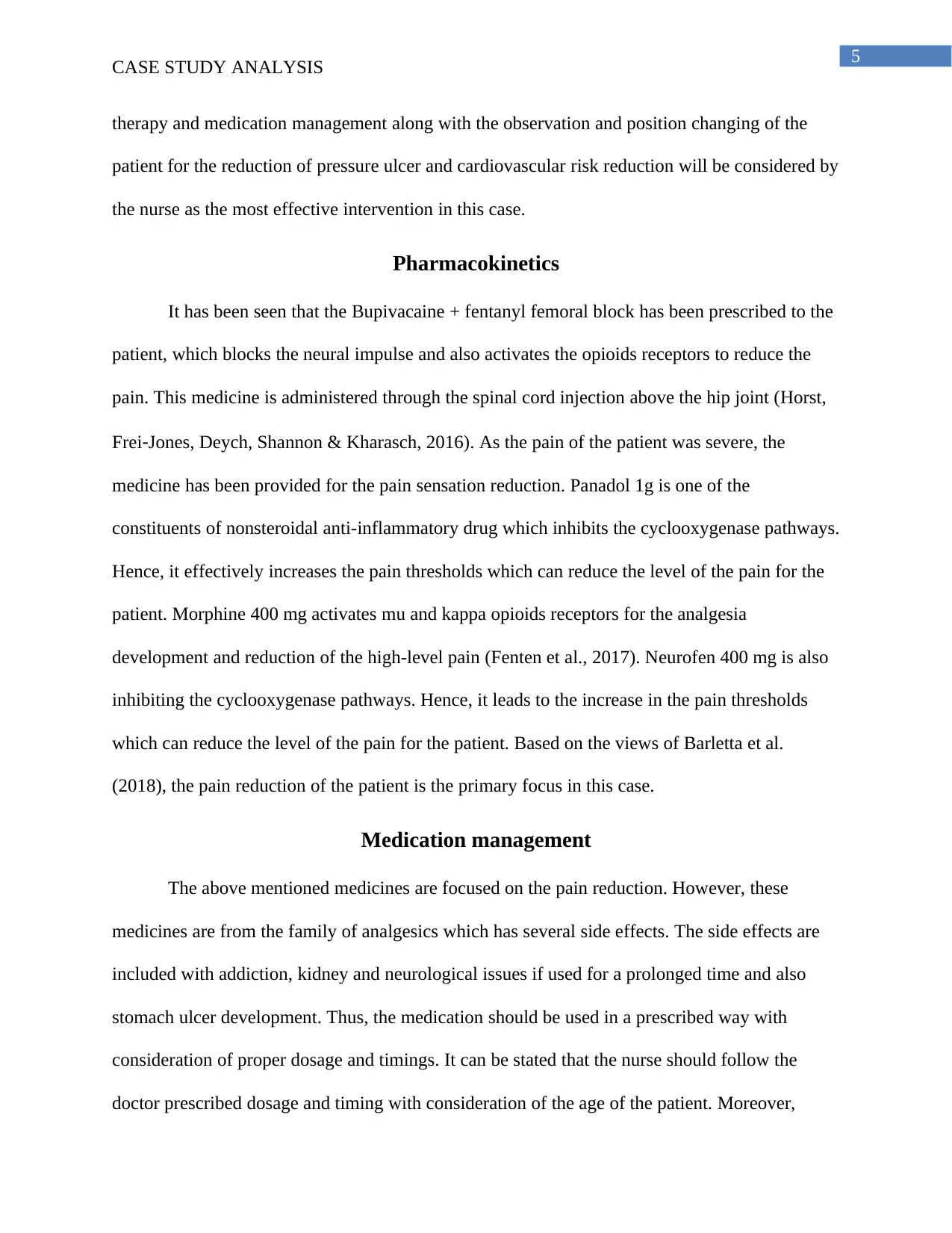
5
CASE STUDY ANALYSIS
therapy and medication management along with the observation and position changing of the
patient for the reduction of pressure ulcer and cardiovascular risk reduction will be considered by
the nurse as the most effective intervention in this case.
Pharmacokinetics
It has been seen that the Bupivacaine + fentanyl femoral block has been prescribed to the
patient, which blocks the neural impulse and also activates the opioids receptors to reduce the
pain. This medicine is administered through the spinal cord injection above the hip joint (Horst,
Frei‐Jones, Deych, Shannon & Kharasch, 2016). As the pain of the patient was severe, the
medicine has been provided for the pain sensation reduction. Panadol 1g is one of the
constituents of nonsteroidal anti-inflammatory drug which inhibits the cyclooxygenase pathways.
Hence, it effectively increases the pain thresholds which can reduce the level of the pain for the
patient. Morphine 400 mg activates mu and kappa opioids receptors for the analgesia
development and reduction of the high-level pain (Fenten et al., 2017). Neurofen 400 mg is also
inhibiting the cyclooxygenase pathways. Hence, it leads to the increase in the pain thresholds
which can reduce the level of the pain for the patient. Based on the views of Barletta et al.
(2018), the pain reduction of the patient is the primary focus in this case.
Medication management
The above mentioned medicines are focused on the pain reduction. However, these
medicines are from the family of analgesics which has several side effects. The side effects are
included with addiction, kidney and neurological issues if used for a prolonged time and also
stomach ulcer development. Thus, the medication should be used in a prescribed way with
consideration of proper dosage and timings. It can be stated that the nurse should follow the
doctor prescribed dosage and timing with consideration of the age of the patient. Moreover,
CASE STUDY ANALYSIS
therapy and medication management along with the observation and position changing of the
patient for the reduction of pressure ulcer and cardiovascular risk reduction will be considered by
the nurse as the most effective intervention in this case.
Pharmacokinetics
It has been seen that the Bupivacaine + fentanyl femoral block has been prescribed to the
patient, which blocks the neural impulse and also activates the opioids receptors to reduce the
pain. This medicine is administered through the spinal cord injection above the hip joint (Horst,
Frei‐Jones, Deych, Shannon & Kharasch, 2016). As the pain of the patient was severe, the
medicine has been provided for the pain sensation reduction. Panadol 1g is one of the
constituents of nonsteroidal anti-inflammatory drug which inhibits the cyclooxygenase pathways.
Hence, it effectively increases the pain thresholds which can reduce the level of the pain for the
patient. Morphine 400 mg activates mu and kappa opioids receptors for the analgesia
development and reduction of the high-level pain (Fenten et al., 2017). Neurofen 400 mg is also
inhibiting the cyclooxygenase pathways. Hence, it leads to the increase in the pain thresholds
which can reduce the level of the pain for the patient. Based on the views of Barletta et al.
(2018), the pain reduction of the patient is the primary focus in this case.
Medication management
The above mentioned medicines are focused on the pain reduction. However, these
medicines are from the family of analgesics which has several side effects. The side effects are
included with addiction, kidney and neurological issues if used for a prolonged time and also
stomach ulcer development. Thus, the medication should be used in a prescribed way with
consideration of proper dosage and timings. It can be stated that the nurse should follow the
doctor prescribed dosage and timing with consideration of the age of the patient. Moreover,
⊘ This is a preview!⊘
Do you want full access?
Subscribe today to unlock all pages.

Trusted by 1+ million students worldwide
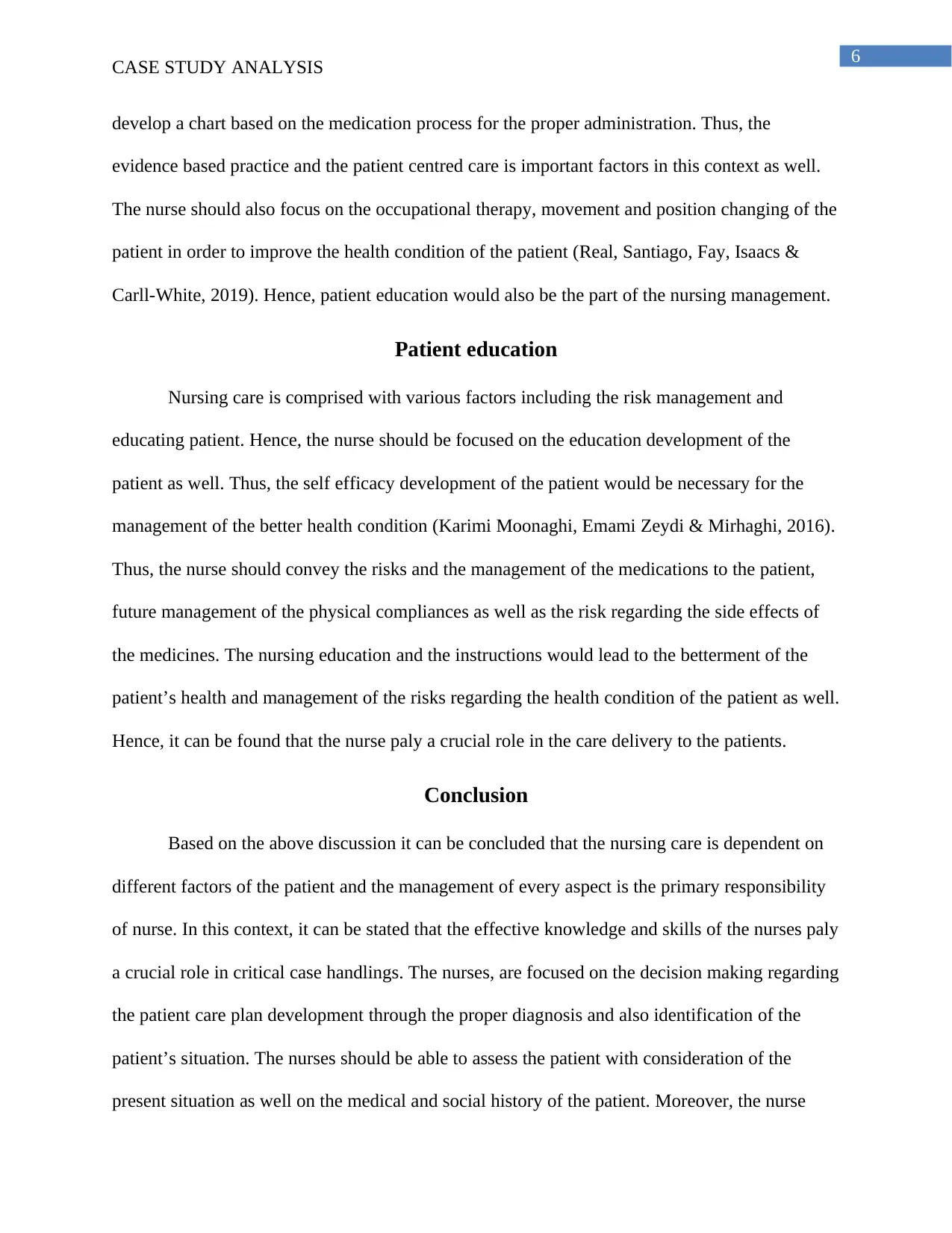
6
CASE STUDY ANALYSIS
develop a chart based on the medication process for the proper administration. Thus, the
evidence based practice and the patient centred care is important factors in this context as well.
The nurse should also focus on the occupational therapy, movement and position changing of the
patient in order to improve the health condition of the patient (Real, Santiago, Fay, Isaacs &
Carll-White, 2019). Hence, patient education would also be the part of the nursing management.
Patient education
Nursing care is comprised with various factors including the risk management and
educating patient. Hence, the nurse should be focused on the education development of the
patient as well. Thus, the self efficacy development of the patient would be necessary for the
management of the better health condition (Karimi Moonaghi, Emami Zeydi & Mirhaghi, 2016).
Thus, the nurse should convey the risks and the management of the medications to the patient,
future management of the physical compliances as well as the risk regarding the side effects of
the medicines. The nursing education and the instructions would lead to the betterment of the
patient’s health and management of the risks regarding the health condition of the patient as well.
Hence, it can be found that the nurse paly a crucial role in the care delivery to the patients.
Conclusion
Based on the above discussion it can be concluded that the nursing care is dependent on
different factors of the patient and the management of every aspect is the primary responsibility
of nurse. In this context, it can be stated that the effective knowledge and skills of the nurses paly
a crucial role in critical case handlings. The nurses, are focused on the decision making regarding
the patient care plan development through the proper diagnosis and also identification of the
patient’s situation. The nurses should be able to assess the patient with consideration of the
present situation as well on the medical and social history of the patient. Moreover, the nurse
CASE STUDY ANALYSIS
develop a chart based on the medication process for the proper administration. Thus, the
evidence based practice and the patient centred care is important factors in this context as well.
The nurse should also focus on the occupational therapy, movement and position changing of the
patient in order to improve the health condition of the patient (Real, Santiago, Fay, Isaacs &
Carll-White, 2019). Hence, patient education would also be the part of the nursing management.
Patient education
Nursing care is comprised with various factors including the risk management and
educating patient. Hence, the nurse should be focused on the education development of the
patient as well. Thus, the self efficacy development of the patient would be necessary for the
management of the better health condition (Karimi Moonaghi, Emami Zeydi & Mirhaghi, 2016).
Thus, the nurse should convey the risks and the management of the medications to the patient,
future management of the physical compliances as well as the risk regarding the side effects of
the medicines. The nursing education and the instructions would lead to the betterment of the
patient’s health and management of the risks regarding the health condition of the patient as well.
Hence, it can be found that the nurse paly a crucial role in the care delivery to the patients.
Conclusion
Based on the above discussion it can be concluded that the nursing care is dependent on
different factors of the patient and the management of every aspect is the primary responsibility
of nurse. In this context, it can be stated that the effective knowledge and skills of the nurses paly
a crucial role in critical case handlings. The nurses, are focused on the decision making regarding
the patient care plan development through the proper diagnosis and also identification of the
patient’s situation. The nurses should be able to assess the patient with consideration of the
present situation as well on the medical and social history of the patient. Moreover, the nurse
Paraphrase This Document
Need a fresh take? Get an instant paraphrase of this document with our AI Paraphraser
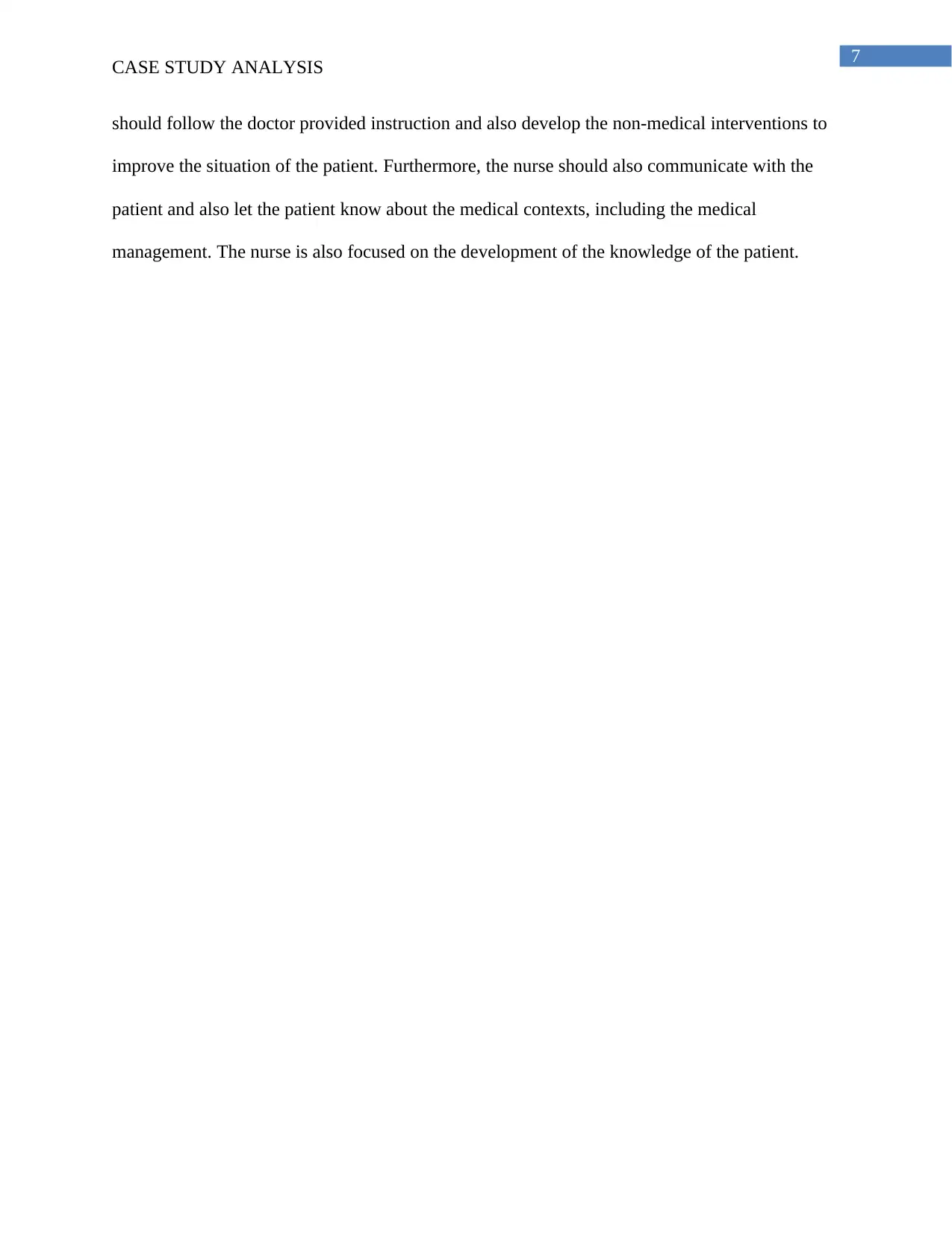
7
CASE STUDY ANALYSIS
should follow the doctor provided instruction and also develop the non-medical interventions to
improve the situation of the patient. Furthermore, the nurse should also communicate with the
patient and also let the patient know about the medical contexts, including the medical
management. The nurse is also focused on the development of the knowledge of the patient.
CASE STUDY ANALYSIS
should follow the doctor provided instruction and also develop the non-medical interventions to
improve the situation of the patient. Furthermore, the nurse should also communicate with the
patient and also let the patient know about the medical contexts, including the medical
management. The nurse is also focused on the development of the knowledge of the patient.
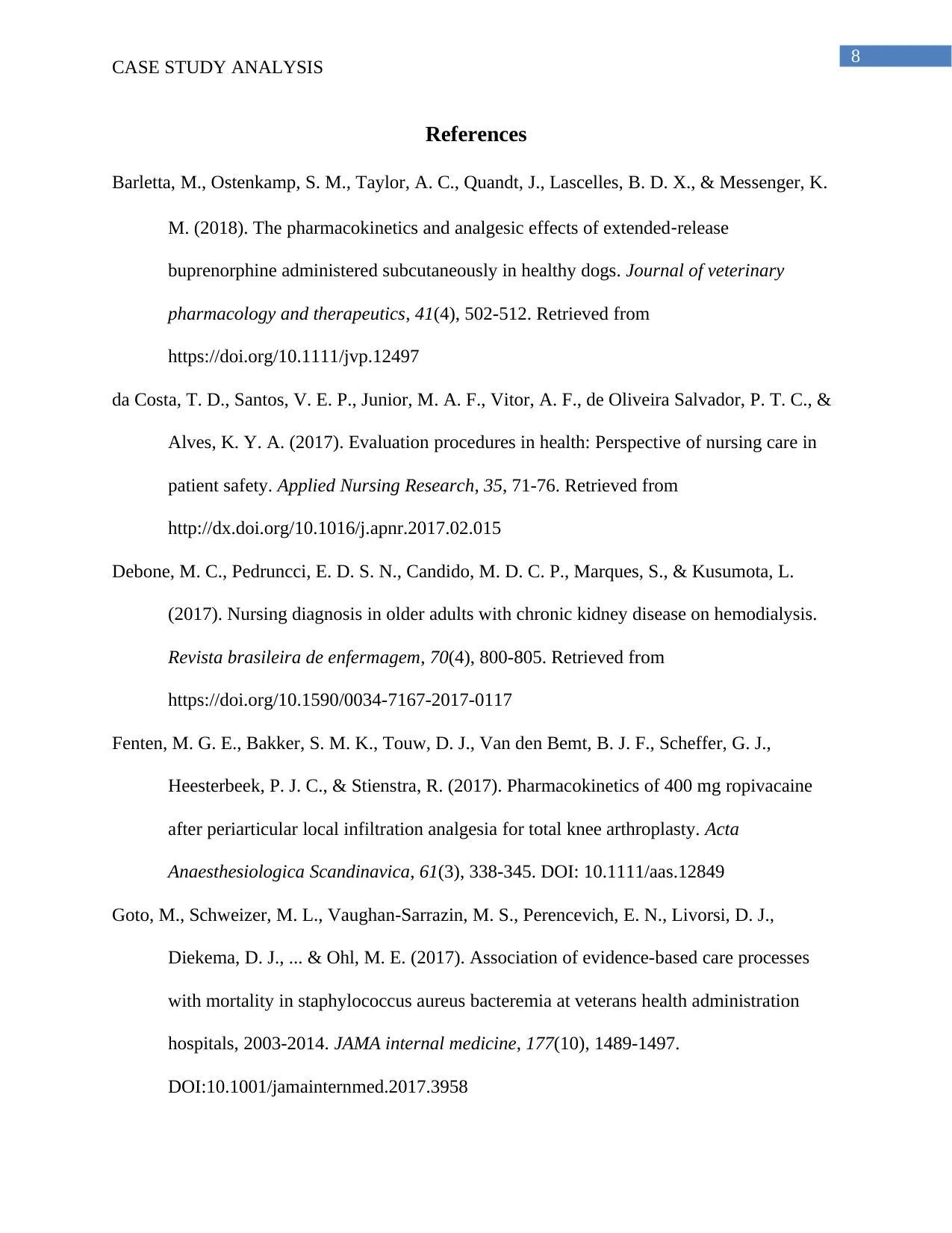
8
CASE STUDY ANALYSIS
References
Barletta, M., Ostenkamp, S. M., Taylor, A. C., Quandt, J., Lascelles, B. D. X., & Messenger, K.
M. (2018). The pharmacokinetics and analgesic effects of extended‐release
buprenorphine administered subcutaneously in healthy dogs. Journal of veterinary
pharmacology and therapeutics, 41(4), 502-512. Retrieved from
https://doi.org/10.1111/jvp.12497
da Costa, T. D., Santos, V. E. P., Junior, M. A. F., Vitor, A. F., de Oliveira Salvador, P. T. C., &
Alves, K. Y. A. (2017). Evaluation procedures in health: Perspective of nursing care in
patient safety. Applied Nursing Research, 35, 71-76. Retrieved from
http://dx.doi.org/10.1016/j.apnr.2017.02.015
Debone, M. C., Pedruncci, E. D. S. N., Candido, M. D. C. P., Marques, S., & Kusumota, L.
(2017). Nursing diagnosis in older adults with chronic kidney disease on hemodialysis.
Revista brasileira de enfermagem, 70(4), 800-805. Retrieved from
https://doi.org/10.1590/0034-7167-2017-0117
Fenten, M. G. E., Bakker, S. M. K., Touw, D. J., Van den Bemt, B. J. F., Scheffer, G. J.,
Heesterbeek, P. J. C., & Stienstra, R. (2017). Pharmacokinetics of 400 mg ropivacaine
after periarticular local infiltration analgesia for total knee arthroplasty. Acta
Anaesthesiologica Scandinavica, 61(3), 338-345. DOI: 10.1111/aas.12849
Goto, M., Schweizer, M. L., Vaughan-Sarrazin, M. S., Perencevich, E. N., Livorsi, D. J.,
Diekema, D. J., ... & Ohl, M. E. (2017). Association of evidence-based care processes
with mortality in staphylococcus aureus bacteremia at veterans health administration
hospitals, 2003-2014. JAMA internal medicine, 177(10), 1489-1497.
DOI:10.1001/jamainternmed.2017.3958
CASE STUDY ANALYSIS
References
Barletta, M., Ostenkamp, S. M., Taylor, A. C., Quandt, J., Lascelles, B. D. X., & Messenger, K.
M. (2018). The pharmacokinetics and analgesic effects of extended‐release
buprenorphine administered subcutaneously in healthy dogs. Journal of veterinary
pharmacology and therapeutics, 41(4), 502-512. Retrieved from
https://doi.org/10.1111/jvp.12497
da Costa, T. D., Santos, V. E. P., Junior, M. A. F., Vitor, A. F., de Oliveira Salvador, P. T. C., &
Alves, K. Y. A. (2017). Evaluation procedures in health: Perspective of nursing care in
patient safety. Applied Nursing Research, 35, 71-76. Retrieved from
http://dx.doi.org/10.1016/j.apnr.2017.02.015
Debone, M. C., Pedruncci, E. D. S. N., Candido, M. D. C. P., Marques, S., & Kusumota, L.
(2017). Nursing diagnosis in older adults with chronic kidney disease on hemodialysis.
Revista brasileira de enfermagem, 70(4), 800-805. Retrieved from
https://doi.org/10.1590/0034-7167-2017-0117
Fenten, M. G. E., Bakker, S. M. K., Touw, D. J., Van den Bemt, B. J. F., Scheffer, G. J.,
Heesterbeek, P. J. C., & Stienstra, R. (2017). Pharmacokinetics of 400 mg ropivacaine
after periarticular local infiltration analgesia for total knee arthroplasty. Acta
Anaesthesiologica Scandinavica, 61(3), 338-345. DOI: 10.1111/aas.12849
Goto, M., Schweizer, M. L., Vaughan-Sarrazin, M. S., Perencevich, E. N., Livorsi, D. J.,
Diekema, D. J., ... & Ohl, M. E. (2017). Association of evidence-based care processes
with mortality in staphylococcus aureus bacteremia at veterans health administration
hospitals, 2003-2014. JAMA internal medicine, 177(10), 1489-1497.
DOI:10.1001/jamainternmed.2017.3958
⊘ This is a preview!⊘
Do you want full access?
Subscribe today to unlock all pages.

Trusted by 1+ million students worldwide
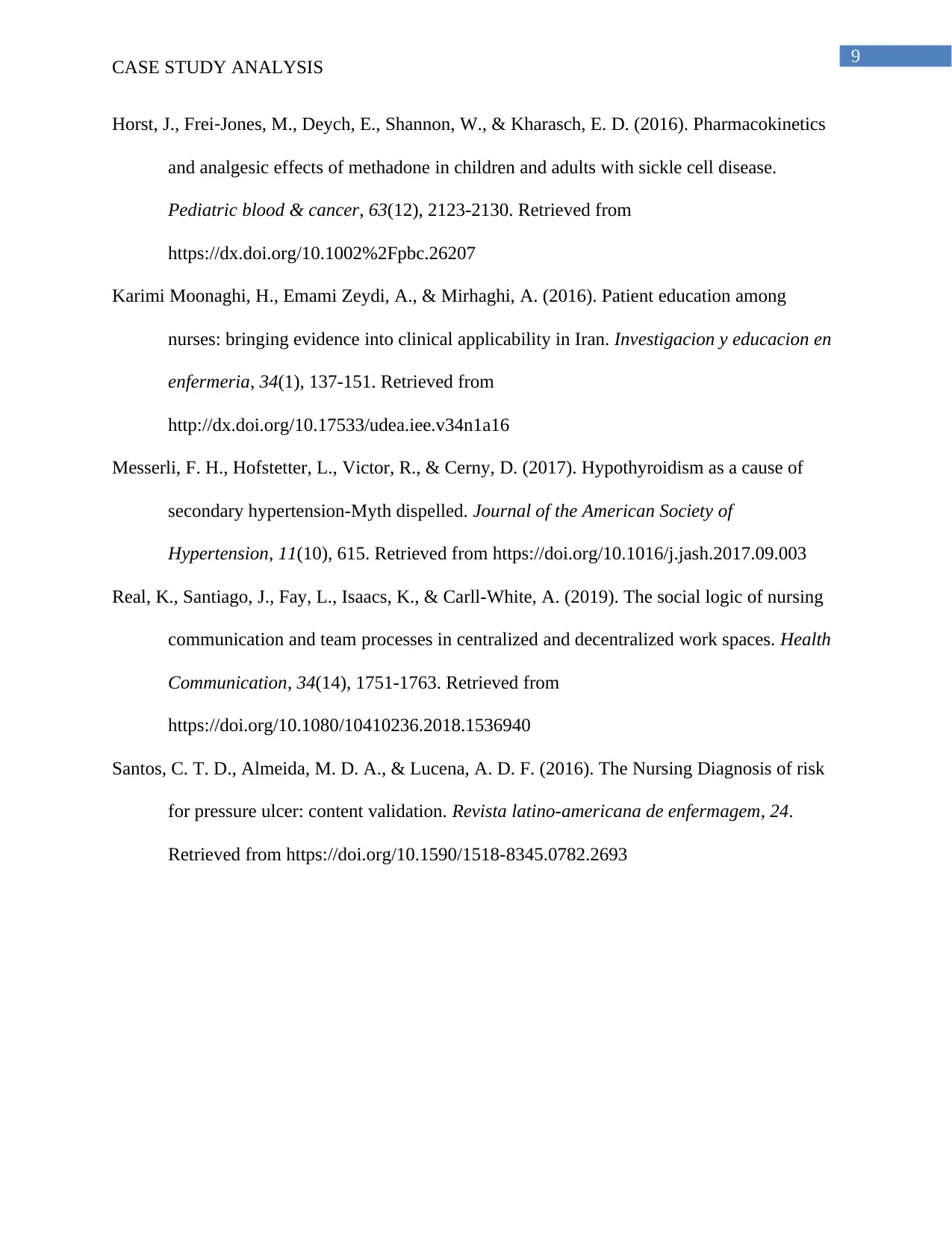
9
CASE STUDY ANALYSIS
Horst, J., Frei‐Jones, M., Deych, E., Shannon, W., & Kharasch, E. D. (2016). Pharmacokinetics
and analgesic effects of methadone in children and adults with sickle cell disease.
Pediatric blood & cancer, 63(12), 2123-2130. Retrieved from
https://dx.doi.org/10.1002%2Fpbc.26207
Karimi Moonaghi, H., Emami Zeydi, A., & Mirhaghi, A. (2016). Patient education among
nurses: bringing evidence into clinical applicability in Iran. Investigacion y educacion en
enfermeria, 34(1), 137-151. Retrieved from
http://dx.doi.org/10.17533/udea.iee.v34n1a16
Messerli, F. H., Hofstetter, L., Victor, R., & Cerny, D. (2017). Hypothyroidism as a cause of
secondary hypertension-Myth dispelled. Journal of the American Society of
Hypertension, 11(10), 615. Retrieved from https://doi.org/10.1016/j.jash.2017.09.003
Real, K., Santiago, J., Fay, L., Isaacs, K., & Carll-White, A. (2019). The social logic of nursing
communication and team processes in centralized and decentralized work spaces. Health
Communication, 34(14), 1751-1763. Retrieved from
https://doi.org/10.1080/10410236.2018.1536940
Santos, C. T. D., Almeida, M. D. A., & Lucena, A. D. F. (2016). The Nursing Diagnosis of risk
for pressure ulcer: content validation. Revista latino-americana de enfermagem, 24.
Retrieved from https://doi.org/10.1590/1518-8345.0782.2693
CASE STUDY ANALYSIS
Horst, J., Frei‐Jones, M., Deych, E., Shannon, W., & Kharasch, E. D. (2016). Pharmacokinetics
and analgesic effects of methadone in children and adults with sickle cell disease.
Pediatric blood & cancer, 63(12), 2123-2130. Retrieved from
https://dx.doi.org/10.1002%2Fpbc.26207
Karimi Moonaghi, H., Emami Zeydi, A., & Mirhaghi, A. (2016). Patient education among
nurses: bringing evidence into clinical applicability in Iran. Investigacion y educacion en
enfermeria, 34(1), 137-151. Retrieved from
http://dx.doi.org/10.17533/udea.iee.v34n1a16
Messerli, F. H., Hofstetter, L., Victor, R., & Cerny, D. (2017). Hypothyroidism as a cause of
secondary hypertension-Myth dispelled. Journal of the American Society of
Hypertension, 11(10), 615. Retrieved from https://doi.org/10.1016/j.jash.2017.09.003
Real, K., Santiago, J., Fay, L., Isaacs, K., & Carll-White, A. (2019). The social logic of nursing
communication and team processes in centralized and decentralized work spaces. Health
Communication, 34(14), 1751-1763. Retrieved from
https://doi.org/10.1080/10410236.2018.1536940
Santos, C. T. D., Almeida, M. D. A., & Lucena, A. D. F. (2016). The Nursing Diagnosis of risk
for pressure ulcer: content validation. Revista latino-americana de enfermagem, 24.
Retrieved from https://doi.org/10.1590/1518-8345.0782.2693
Paraphrase This Document
Need a fresh take? Get an instant paraphrase of this document with our AI Paraphraser

10
CASE STUDY ANALYSIS
CASE STUDY ANALYSIS
1 out of 11
Related Documents
Your All-in-One AI-Powered Toolkit for Academic Success.
+13062052269
info@desklib.com
Available 24*7 on WhatsApp / Email
![[object Object]](/_next/static/media/star-bottom.7253800d.svg)
Unlock your academic potential
Copyright © 2020–2025 A2Z Services. All Rights Reserved. Developed and managed by ZUCOL.





